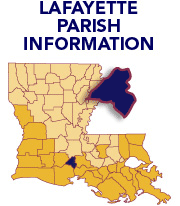|
Lafayette Parish
Disaster Needs and Impact Assessment
Transportation and Infrastructure
While Lafayette Parish did not experience a direct hit from either storm, and thus avoided serious direct infrastructure damage, critical needs were exposed as a result of each. In particular, the estimated 8.25% increase in population since August of 2005 has overloaded the existing transportation infrastructure, rendering it incapable of handling daily traffic condition. In addition to daily traffic needs, these storms have amplified the need for more adequate and efficient evacuation routes to service Lafayette Parish and those southerly Parishes that must travel through Lafayette to evacuate.
• Existing transportation infrastructure is over capacity, preventing efficient and/or timely movement through the Parish. Existing systems need to be modernized to alleviate demand on the system and better equip the Parish to deal with emergency evacuations;
• Interstate frontage roads and interchanges are needed to further circulate traffic through the Parish and to allow for the activation of the State of Louisiana Contra-Flow Plan in the case of a large-scale hurricane evacuation;
• Significant investments need to be made in existing structures, including bridges and roadways, to increase road capacity for residents and evacuations;
• Completion of critical links between existing roadways and interstates needs to occur to improve daily residential and commercial circulation, and to facilitate evacuations from the 5 Parish area.
Along these lines, US 90, which serves as a critical evacuation route through southern Lafayette and northern St. Martin Parishes crosses a flood plain for a distance of approximately 1/2 mile. While recent hurricanes have been relatively dry in advance of landfall, there is a regional concern that a slow moving storm that drops significant amounts of rain in advance of landfall will inundate this segment of roadway, preventing the evacuation of approximately 100,000 evacuees from Iberia, Lower St. Martin, St. Mary, Terrebonne, and Lafourche Parishes.
• Since this route is a major multi lane evacuation route for several Parishes, there is a need to address increased capacity and reduced levels of service.
• The Parish must design and install a drainage system in this area to prevent flooding during normal rain and storm event.
Housing and Community Development
While Lafayette Parish was spared the widespread damage to the housing stock that occurred in other areas, it did not come through the 2005 hurricane season unscathed. According to Louisiana Recovery Authority estimates, nearly 5,000 housing units, or 6.4% of the total housing stock, suffered damage as a result of Hurricane Rita. Of this, 120 units suffered major or severe damage. This, in addition to estimated population increases as high as 40,000 residents relocating from other Parishes, has caused a serious shortage of affordable and adequate housing for residents. As of January 2006, nearly all of the available existing residential structures in the Parish had been sold. Further, as of November 2006 there were still more than 330 FEMA trailers acting as temporary housing for victims of both storms. It should also be noted that the loss of over 100,000 residences in New Orleans alone, even those residents who desire to return home might have to wait several years to do so. Thus acceptable and affordable options for housing are needed immediately to address the current shortage and to accommodate the growth of Lafayette Parish.
• Vacant lots in the McComb addition are prime for affordable housing development. The purchase of lots for infill redevelopment will allow the Parish to return these lots to commerce and accommodate the need for affordable housing in the Parish.
• Lafayette Consolidated Government construction of affordable single-family homes will alleviate the housing shortage for residents and families displaced by the hurricanes.
• Repetitive loss structures in the Parish need mitigation against future storm damage. This will include elevating structures and acquisition/demolition of properties in various locations throughout the Parish.
In addition to the near-term housing requirements, Lafayette Parish needs to plan for long-term growth and expansion. In particular, rapid population, direct storm impacts, and the potential to manage future development according to Smart Growth principles need to be addressed in four key elements of the Lafayette in a Century (LINC) comprehensive plan for the Parish.
• Prior to Hurricane Rita, the drainage and storm water element of LINC was the top priority and nearing completion. While the storm delayed work on this element, the Parish still regards this as the top priority for planning and future development. It is critical that the drainage/storm water element be completed as soon as possible.
• Housing construction in the Parish has reached its highest levels since the oil boom of the 1980’s. While the Parish was working on the affordable housing component of the master plan before the storms, it was necessary to delay further work in this area. Completion of the Housing/Neighborhoods is imperative to address affordability issues and to direct housing construction in an orderly and coordinated manner.
• Currently the Parish has a partial land use plan, but needs to move beyond the preliminary planning phase to ensure Smart Growth and economically viable development.
• In addition to the immediate needs of the transportation system outlined above, the Parish must address and plan for long-term street connectivity, infrastructure upgrades, and emergency transportation needs.
Currently Lafayette Parish lacks a centralized location for human/community services, non-profit agencies, and/or disaster staging. The storms of 2005 demonstrated the need for a community center to deal with the ongoing needs of disaster victims and the daily needs of local residents. In particular, a consolidated center that houses resources, agencies, and individuals is viewed as a critical component for community development in Lafayette Parish.
• United Way of Acadiana Multi-Tenant Center will allow non-profit organizations from Lafayette and other Parishes to coalesce and effectively address the short- and long-term needs of the community on a daily basis and in the event of a disaster.
|







